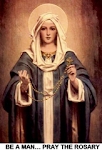
Bishop Edward Slattery of Tulsa, Oklahoma, has recently returned to the practice of saying Holy Mass ad orientam in his cathedral. In the diocesan periodical he gave an excellent little catechesis on the merits of ad orientam and why the Church ought to return to this posture. Bishop Slattery said:
"From ancient times, in the celebration of the Mass, everyone - celebrant and congregation - faced the same direction, since they were united with Christ in offering to the Father Christ's unique, unrepeatable and acceptable sacrifice. When we study the most ancient liturgical practices of the Church, we find that the priest and people faced in the same direction, usually toward the east, in expectation that when Christ returns, He will return 'from the east.' At Mass, the Church keeps vigil, waiting for that return. This single position is called ad orientam, which simply means 'toward the east.'
Having the priest and people celebrate Mass ad orientam was the liturgical norm for nearly 18 centuries. There must have been solid reasons for the Church to have held on to this posture for so long. And there were! First of all, the Catholic liturgy has always maintained a marvelous adherence to the Apostolic Tradition. We see the Mass, indeed the whole liturgical expression of the Church's life, as something which we have received from the Apostles and which we, in turn, are expected to hand on intact (1 Cor. 11:23).
Secondly, the Church held on to this single eastward position because of the sublime way it reveals the nature of the Mass. Even someone unfamiliar with the Mass who reflected upon the celebrant and the faithful being oriented in the same direction would recognize that the priest stands at the head of the people, sharing in one and the same action, which was-he would note with a moment's longer reflection - and act of worship.
In the last 40 years, however, this shared orientation was lost...The priest faces the people while the people face the priest, even though the Eucharistic Prayer is directed to the Father and not to the people. Unfortunately, this change had a number of unforeseen and largely negative effects. First of all, it was a serious rupture with the Church's ancient tradition. Secondly, it gave the appearance that the priest and the people were engaged with a conversation about God rather than the worship of God. Thirdly, it places an inordinate importance on the personality of the celebrant by placing him on a kind of liturgical stage.
Even before his election as the successor to St. Peter, Pope Benedict has been urging us to draw upon the ancient liturgical practices of the Church to recover a more authentic Catholic worship. For that reason, I have restored the venerable ad orientam position when I celebrate Mass at the Cathedral.
This change ought no to be misconstrued as the Bishop 'turning his back on the faithful,' as if I am being inconsiderate or hostile. Such an interpretation misses the point that, by facing in the same direction, the posture of the celebrant and the congregation make explicit the fact that we journey together to God. Priest and people are on the pilgrimage together.
It would also be a mistaken notion to look at the recovery of this ancient tradition as a mere 'turning back of the clock,'...His Holiness wants us to discover what underlies this ancient tradition and made it viable for so many centuries, namely, the Church's understanding that the worship of the Mass is primarily and essentially the worship which Christ offers to His Father."

























No comments:
Post a Comment